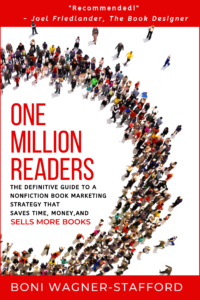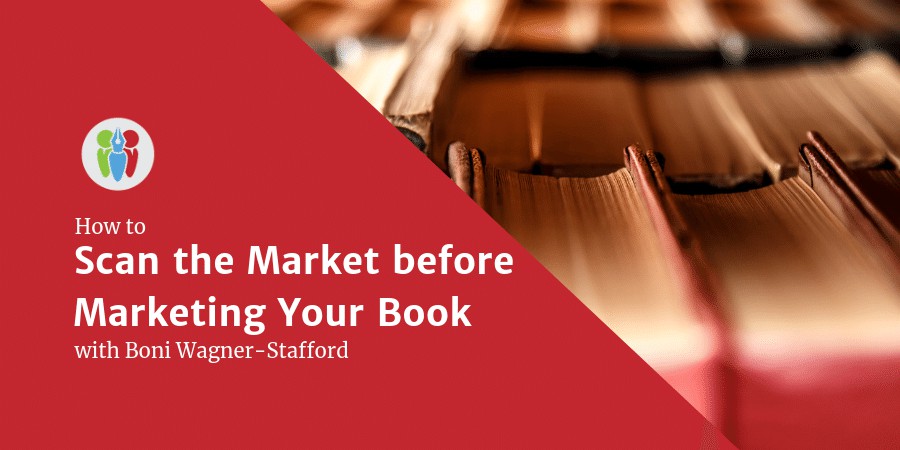It’s common to check out competitor books, titles, covers, and prices before we set our own. And that’s a good thing. As ALLi Communications Manager Boni Wagner-Stafford (also of Recommended Partner Member Ingenium Books) tells us in this adapted excerpt from her new book, One Million Readers, it's a good idea to do a thorough market scan before marketing your book.

Boni Wagner-Stafford, ALLi Communications Manager
In my view, a book marketing strategy that doesn’t include a ‘market scan’ is not going to help you do the best marketing job for your book. One that does is going to empower you and give you that delicious sense of control.
What Is a Market Scan?
A market scan looks at what's happening externally that relates to the genre, subject, or focus of your book. And it helps you explore why readers will want to buy your book. This is an approach equally beneficial to authors of fiction and nonfiction. (Though at Ingenium Books we work exclusively with nonfiction authors and therefore we skew that way.)
I also use the term ‘environmental scan.’ It's a throwback to my days doing communications and PR strategies in government: we had to know what had happened, what was happening, and what was about to happen in the broader environment before we went out to the public or stakeholders with any new policy, directive, or initiative. It’s that experience that leads me to consider this a foundational piece of work for every book marketing strategy.
In a market scan you’ll look at how books in your genre are selling, who the successfully-selling authors are, where your genre stacks up in overall book sales, and what formats sell best and worst in your genre. It’s also where you’ll take a look at the broader environment to see what is happening in the world relative to your genre and the subject areas within your book.
Why Scan the Market Before Marketing Your Book?
In One Million Readers, I advocate doing a huge chunk of your marketing strategy planning before you start writing your book. Certainly before you finish. But after it's written is better than not doing it at all.
Looking at both the market and the environment helps orient you to the broader forces at work on your readers. It’s about more than who your readers are or where you’re going to find them. It is going to help you answer these questions:
- Why will readers want to buy your book?
- Why now?
- What opportunities are there for you to get in front of the reader that you may not have thought of?
- What else is happening in the world that could impact your book’s success?
- What external factor might give you a good hook for a media release and increase your chances of getting picked up for a news story?
How to Scan the Market
Competitors
Start the market scan by looking at competitors. This will give you all sorts of information, from ideas on cover design, based on ones you see that you like and that you think are effective, what sorts of covers readers in the genre seem to prefer (checking sales rank), what titles work or don’t work, what are the average, high and low prices, what categories are being used by competitors, and which categories might hold some opportunity.

Photo by Edi Libedinsky on Unsplash
To do this, check Amazon, Goodreads, and also perform a straight Google search. Sometimes a competitor book will pop up in Google that either isn’t on one of the other platforms, or that you somehow missed.
Next, search by general subject matter and dig around a little deeper into the categories. See what books you find listed there. Take screen shots of the covers and put them into a table so you can create a grid to see them all together without all the competing text. (I just use a simple Word or Google doc table for this.) Create a spreadsheet that includes the title, author, publish date, publisher, number of reviews and the average star rating, and price. If you have Publisher Rocket, KDSpy, or K-Lytics you will also be able to tell average daily and monthly sales for competitor titles and categories.
Retail Data
 If you’re wondering why you should care about how many books are selling in which country and in which genre, here’s a hypothetical parallel example related to a new invention. Imagine you have a great idea for a new product that you think is going to revolutionize the way people tie their shoes.
If you’re wondering why you should care about how many books are selling in which country and in which genre, here’s a hypothetical parallel example related to a new invention. Imagine you have a great idea for a new product that you think is going to revolutionize the way people tie their shoes.
You would not invest in the time to patent, prototype, manufacture, and market this new product before you did some research into the broader market. What is the shoe sales industry worth? How many pairs of shoes does the average person buy over his or her lifetime, in the US? Canada? India? What are the most common types of shoe-fasteners out there and what’s the history? What are the problems with the way people tie their shoes now? Is anyone else already selling what you think you’ve invented? Has anyone else written a book about this?
It’s the same with your book. You want to build at least a bit of knowledge about the industry and economic environment into which you are launching your book, which is your product.
Check sources like Statista for US books sales and publishing industry data and, depending on the genre, you might head over to the OECD website, check Statistics Canada, and try to find aggregated sales figures for trade and self-published books across all genres. And then there’s Bookstat, which is the company spun out of the formerly anonymous “Data Guy” quarterly author earnings reports that seemed to dig deeper into the data than anyone else was able to do.
If you’re a prolific writer, you may not need to do this exercise with every book. However, I recommend you do this work at least once per year. Meaning, if you are publishing three books per year, you probably only have to check the retail data after every third book.
Environment

Photo by Jenni Jones on Unsplash
The “environment” is the socio-economic climate into which you want to release your book. Look for news stories that focus on the topic of your book. Watch for governmental statements or initiatives that might be related to your subject area. Think about economic factors and social, technological, or leisure trends. Look at these locally, regionally, nationally, and globally.
- If you’re writing a book about addiction, you’d look for statistics about how many people are struggling with addiction. You’d also look at how society and the media treat addiction-related themes, such as the opioid crisis, or celebrities who have opened up about their own struggles with addiction.
- If you’ve written a science fiction book that, for example, talks about futuristic biometric technology, you’d do enough additional research so that you know what’s happening with the technology at the moment, and you’ll look at what that tells you about who’s interested in that subject matter and what some of the issues are.
You’ve likely done much of this research in the course of writing your book. However, a lot can change in between your initial research of the subject and now, when you’re ready to plan your marketing.
Flying with Dad Environmental Scan
 By way of example, here is the narrative treatment of the environmental scan section for Ingenium Books author Yvonne Caputo’s forthcoming memoir, Flying with Dad:
By way of example, here is the narrative treatment of the environmental scan section for Ingenium Books author Yvonne Caputo’s forthcoming memoir, Flying with Dad:
The anniversaries of a number of significant World War events occur in 2018 and 2019. There will be widespread commemorative events in the UK in November of 2018 to mark the 100th anniversary of the end of WWI. The 75th anniversary of the D-Day invasion of Europe will be commemorated around the world in 2019.
To this day, there are strong memories of the one-and-a-half million American GIs who landed in Britain – the “Friendly Invasion” – and their cultural influence. According to statistics from the US Department of Veterans Affairs, 558,000 of the sixteen million Americans who served in World War II were still alive in 2017.
In popular culture, recent films such as Churchill and Dunkirk add to the environment of remembering war events. Additionally, the widespread occurrence of post-traumatic stress disorder or PTSD and the healing power of storytelling are related to one of the aspects of the book.
The heightened awareness of military history and those who fought make it an ideal time for the release of Flying with Dad.
It might seem obvious. Or you might be surprised how clarifying it can be to do this work with purpose, and how it can help you see exactly who to target with your marketing and why. For Flying with Dad, we immediately identified globally-significant events that would raise the profile of one of the main subjects and settings in Caputo’s book: her father’s experience as a navigator flying B-24 bombers during WWII. The people that are interested in, attending, and following these events are likely to be more interested in buying and reading Flying with Dad.
Trends, Statistics, Influencers
Whether you’ve written a cozy mystery that features a DNA test or online dating, or you’ve written a business book, you’ll also want to dig into trends, statistics and research industry influencers before marketing your book.
For a business book about meeting facilitation, for example, you’d research how many meetings there are every day, every month, what the average cost of a meeting is, what the latest research from Harvard Business School says, what the trends are, and so on. You may have included some of this information in the content of the book. Some of it may get incorporated into other marketing materials, such as speeches or presentations. It makes it easier to make the case for why the book is relevant and how it can help solve the reader’s problem.
Identifying influencers is a key benefit as well. For Yvonne Caputo, identifying the commemoration and memorial events led us to connecting with community organizers, bomb group and platoon reunions, war-focused libraries, museums, and more. You might find out who organizes the main conferences talking about your subject matter, study groups looking into a main topic in your book, research studies underway, and more. All of which is great info to have before marketing your book.
One Million Readers
 By all means, continue checking out the titles, covers, and prices of your competitor’s books before you launch and before marketing your book. But dig a little deeper and look wider afield, too. You'll be amazed at the ideas and opportunities generated by the additional context. I cover the market scan and much more related to creating your own marketing strategy in One Million Readers: The Definitive Guide to a Nonfiction Book Marketing Strategy That Saves Time, Money, and Sells More Books.
By all means, continue checking out the titles, covers, and prices of your competitor’s books before you launch and before marketing your book. But dig a little deeper and look wider afield, too. You'll be amazed at the ideas and opportunities generated by the additional context. I cover the market scan and much more related to creating your own marketing strategy in One Million Readers: The Definitive Guide to a Nonfiction Book Marketing Strategy That Saves Time, Money, and Sells More Books.
You want to build at least a bit of knowledge about the industry and economic environment into which you are launching your book #IARTG #indieauthor #bookmarketing #amwriting Share on X
OVER TO YOU
Have you done a market scan for your books? Did you find it useful? If not, do you think it might be of some benefit before marketing your book?
If you enjoyed this post, you might like these from the ALLi archive:





So many good, solid tips and ideas here, Boni. Thanks for the great article! I’ve printed it out to review further at my weekly admin/outreach meeting. I especially liked what you said here, “You want to build at least a bit of knowledge about the industry and economic environment into which you are launching your book, which is your product.” So often it’s easy for us “creators” to forget about the business side of things. While it’s challenging, seeing our books as “products” does make it easier to see how/where they fit into the marketplace.
Thanks again for the helpful info.
J P Choquette I do so apologize for the delay in responding and thanking you for your comment! I am not sure how I missed it. I hope the information here is still proving helpful for you. 🙂 Thanks so much and glad you enjoyed the article.
“And then there’s Bookstat, which is the company spun out of the formerly anonymous “Data Guy” quarterly author earnings reports that seemed to dig deeper into the data than anyone else was able to do.”
I’m mystified by this one, Boni. Data Guy shut down the Author Earnings site many months ago. It anyway hadn’t been quarterly for several years (one a year in 2017 and 2018), and the reports were of questionable value given the numbers were estimates at best, double-counted categories and completely ignored key sectors like digital libraries.
OverDrive alone had a quarter billion downloads in 2018. (https://thenewpublishingstandard.com/2018-750000-digital-book-downloads-day-went-uncounted-nielsen-bookscan-data-guys-bookstat-fuelling-nonsense-people-reading-less/
BookStat has NEVER been available to indie authors. You need a $10 million turnover just to get considered to buy into the database.
“If your company’s annual revenues are $10 million or more, and you think Bookstat’s sales data dashboard might be a good match for your business needs, give us a shout.”
Great feedback and info, Mark! I was referring to Bookstat as a high-level research tool, in part to help orient an author to the notion of poking around to learn what’s happening with book sales. Agreed it will not work for the sophisticated or advanced author-publisher looking for a deeper dive.